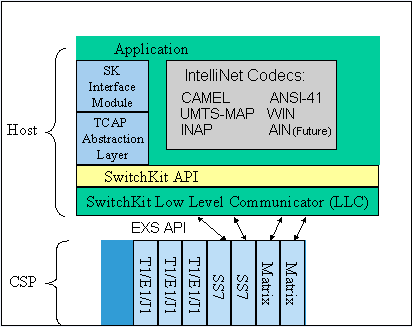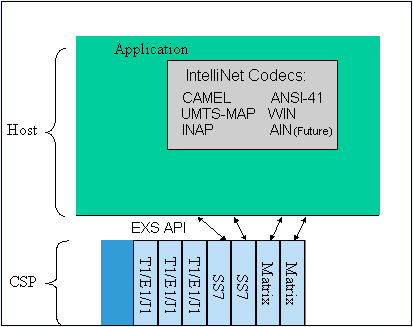
You are here: Intelligent Network & Wireless Protocols Overview > 1 Intelligent Network and Wireless > Introduction

As software developers create more applications that are being deployed and maintained in mobile and intelligent networks, Cantata Technology is keeping pace by introducing support for intelligent network (IN) and wireless protocols in the CSP. Excel’s API supports IN application development enabling Excel API customers to create sophisticated IN applications for deployment on the CSP. For customers who prefer to use SwitchKit as their application development tool, the IN protocols that Cantata supports can communicate with a CSP using SwitchKit API and the SwitchKit component, Low-Level Communicator (LLC). Using SwitchKit to create IN applications can significantly reduce the development cycle, especially with the availability of two new components that perform abstraction from the signaling foundation technologies.
The CSP currently operates effectively as a Service Node (SN) in many production networks. The addition of IN protocols allows the CSP to also serve effectively as:
• A Service Control Point (SCP)
• An Intelligent Peripheral in emerging Intelligent Networks.
Excel’s Platform initially supports five protocols, developed by IntelliNet Technologies, to access IN and wireless networks starting with release 8.2.2 CI. Additional capabilities will be included in future releases.
• Customized Application for Mobile network Enhanced Logic (CAMEL)
• Universal Mobile Telecommunications System- Mobile Application Part (UMTS- MAP) which includes Global System for Mobile communication - Mobile Application Part (GSM-MAP)
• Intelligent Network Application Protocol (INAP)
TIA/ANSI standard
• ANSI - 41
• Wireless Intelligent Network (WIN)
• AIN (planned for future availability)
Advanced Intelligent Network (AIN) conforms to BELLCORE Generic Requirements AIN0.2 GR 1299 (Issue 4, 09/97).
For more details on IntelliNet’s IN protocols see, the following documents (Available from Cantata Technology):
• CAMEL User’s Guide, document part number P_EXCL_CAMEL_UG_2.0
• UMTS MAP User’s Guide, document part number P_EXCL_UMTS_MAP_UG_2.0
• WIN User’s Guide, document part number P_EXCL_WIN_UG_2.0
• ANSI 41D User’s Guide, document part number P_EXCL_AS41D_UG_2.0
• INAP User’s Guide, document part number P_EXCL_INAP_UG_2.0
The IN protocols are implemented on the CSP through the offering of IntelliNet’s protocol-specific encoder/decoder software (codecs). See Codecs for a description of the codecs used with each IN protocol.
SwitchKit IN and Wireless Components
Cantata offers two optional SwitchKit layers that perform abstraction/adaptation from the signaling foundation technologies:
• SwitchKit TCAP Abstraction Layer (SKTAL)
• SwitchKit Interface Module (SKIM)
Use of the SwitchKit TCAP Abstraction Layer and the SwitchKit Interface Module is intended to simplify the work required for the application developer. Use of these components is optional; however, SKIM requires the use of SKTAL.
SwitchKit TCAP Abstraction Layer
The SwitchKit TCAP Abstraction Layer is used to create a generic view of the CSP’s TCAP layer.
The Switchkit Interface Module provides an API interface to abstract services from the TCAP and SCCP layers to a transaction-based application.
The IN application, codecs, and SwitchKit reside on the host computer, using the SS7 services of the CSP.
The next two diagrams show where the IntelliNet IN and wireless protocols and abstraction layers fit into the CSP architecture.
In addition to implementing the required service logic, the application developer must handle the message flow between the IntelliNet codecs and the SS7 protocol stack on the CSP, using SKIM and SKTAL (as desired) and the SwitchKit API and LLC components.
All elements of this offering support threadsafe operations.
Scenario for SwitchKit Users with SKIM and SKTAL

Scenario for SwitchKit Users with SKTAL Only

Application developers who do not use the SwitchKit Interface Module and or the SwitchKit TCAP Abstraction Layer must implement equivalent functionality to manage communication with the CSP, handle the TCAP dialogues, and format messages to and from the codec APIs.
The IN and wireless application and codecs reside on the host computer using the SS7 services of the CSP.
In addition to implementing the required service logic, the application developer must handle the message flow between the IntelliNet codecs and the SS7 protocol stack on the CSP, using Excel API.

The IntelliNet IN and wireless codecs are provided to developers as application layer APIs in the form of header files and software libraries of protocol-specific ASN.1 encoders/decoders. The encoders/decoders are delivered to customers in binary format, available for linking with the application developer’s software and (optionally) SwitchKit to form an executable image. These libraries execute on a host computer, not the CSP.
The IN and wireless protocols are capable of operating in redundant, partially redundant, and non-redundant CSP environments. This includes optional redundancy for each of the following components:
• Host machine
• LLC
• Matrix cards
• SS7 cards
• Line cards